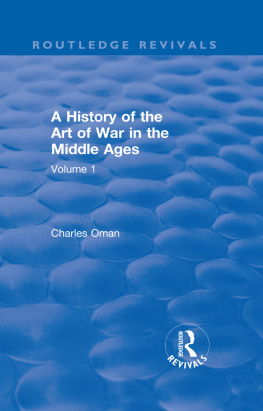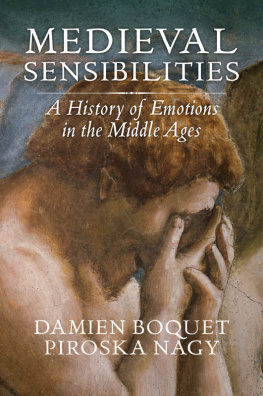Norman F. Cantor - The Civilization of the Middle Ages
Here you can read online Norman F. Cantor - The Civilization of the Middle Ages full text of the book (entire story) in english for free. Download pdf and epub, get meaning, cover and reviews about this ebook. year: 2015, publisher: Harper Perennial, genre: Science / Art. Description of the work, (preface) as well as reviews are available. Best literature library LitArk.com created for fans of good reading and offers a wide selection of genres:
Romance novel
Science fiction
Adventure
Detective
Science
History
Home and family
Prose
Art
Politics
Computer
Non-fiction
Religion
Business
Children
Humor
Choose a favorite category and find really read worthwhile books. Enjoy immersion in the world of imagination, feel the emotions of the characters or learn something new for yourself, make an fascinating discovery.
- Book:The Civilization of the Middle Ages
- Author:
- Publisher:Harper Perennial
- Genre:
- Year:2015
- Rating:4 / 5
- Favourites:Add to favourites
- Your mark:
- 80
- 1
- 2
- 3
- 4
- 5
The Civilization of the Middle Ages: summary, description and annotation
We offer to read an annotation, description, summary or preface (depends on what the author of the book "The Civilization of the Middle Ages" wrote himself). If you haven't found the necessary information about the book — write in the comments, we will try to find it.
The Civilization of the Middle Ages — read online for free the complete book (whole text) full work
Below is the text of the book, divided by pages. System saving the place of the last page read, allows you to conveniently read the book "The Civilization of the Middle Ages" online for free, without having to search again every time where you left off. Put a bookmark, and you can go to the page where you finished reading at any time.
Font size:
Interval:
Bookmark:
To Sir Geoffrey Elton
This book is an extensively revised, thoroughly updated, and substantially expanded version of Medieval History, The Life and Death of a Civilization (New York: Macmillan, 1963; second edition, 1968; revised paperback edition, 1974). About one-third of the text is now different from the old version of this book. The old book went through some fourteen printings and was a main selection of the History Book Club, which offered it to its subscribers for nineteen years. It was widely used as a college textbook. The old book was still in print in 1991. Although its core was still viable, it needed major revision, which this book achieves.
Intellectually, the main changes and additions in this version reflect the extensive publication on social structure, particularly on womens and family history and on medieval piety and heresy in the past three decades. Greater attention has now been given to the impress of the heritage of the ancient world on the preconditioning of medieval civilization, and the section on patristic thought has been extensively rewritten. The major change between the earlier version and this one is in the latter part of the book, on the fourteenth and fifteenth centuries, which is almost entirely different in this version and greatly expanded. Whereas in the old book the fourteenth and fifteenth centuries were treated as a sort of epilogue to medieval civilization, here they are given the same kind of comprehensive narrative treatment as in the rest of the book. This treatment reflects both the enormous body of new historical literature on the late Middle Ages in recent decades and my changed perception of the later centuries of the medieval era. The bibliography in this volume is completely different from the last edition of the old book. It incorporates titles up to 1992.
The first version of this book had a historiographical introduction and some further discourses on how the Middle Ages have been interpreted in the twentieth century. That material has now been rendered superfluous and thoroughly superseded by my recent book Inventing the Middle Ages (William Morrow, 1991; Lutterworth, 1992; Quill paperback, 1993), which is a companion volume to this book. Anyone who reads both books will have a full comprehension of both the narrative development of the Middle Ages and the course of their historiographical interpretation in this century. Inventing the Middle Ages was also a main selection of the History Book Club, the generous patron of humanistic history.
This revised and expanded version retains the character of the original version, namely a focus on cultural, intellectual, and religious history, considered within social and political contexts. The popular impression of the Middle Ages as the Age of Faith and one whose consciousness and sensibility were dominated by the western church is, like most popular historical images, not wrong. What is needed, however, is to articulate that impression in terms of the actual development of medieval religious culture in its interaction with social and material forces, so that the perception of the Middle Ages as a faith-centered culture will be grounded in the reality that historical research can establish. This is what this book tries to do, presenting this information in a readable narrative that highlights prominent personalities.
When I first published this book, I was teaching a hundred students a semester in the introductory course in medieval history at Columbia University and Barnard College. In spring 1992, I was teaching the same number of students in the same course at New York University. I have maintained my connection with young minds, and I draw upon this experience in this version to present to students, as well as to mature lay readers, what I think they want to know about the Middle Ages.
I wish to thank the Macmillan Company of New York for transferring its old copyright on this book; the Office of the Dean of Arts and Science at New York University for providing secretarial and technical support; my secretary, Nelly Fontanez, for immensely valuable assistance in preparing the manuscript for the press; my literary agent, Alexander Hoyt; and my wife, Mindy Cantor, for her help and advice.
New York
August 1992
This heavenly city, then, while it sojourns on earth, calls citizens out of all nations, and gathers together a society of pilgrims of all languages, not scrupling about diversities in the manners, laws, and institutions whereby earthly peace is secured and maintained, but recognizing that, however various these are, they all tend to one and the same end of earthly peace.
St. Augustine of Hippo, Algeria c.425
trans. Marcus Dodds
There are some who wish to learn for no other reason than that they may be looked upon as learned, which is a ridiculous vanity.... Others desire to learn that they may morally instruct others; that is love. And, lastly, there are some who wish to learn that they may be themselves edified; and that is prudence.
St. Bernard of Clairvaux, France c. 1145
trans. S. J. Eales
Bernard of Chartres, the most abounding spring of letters in Gaul in modern times, followed this method.... Where the subject of his own lesson had reference to other disciplines, these matters he brought out clearly in such wise that he did not teach everything about each topic, but in proportion to the capacity of his audience dispensed to them in time the due measure of his subject.... And he brought it about that he who imitated his predecessors became worthy of imitation by his successors.
John of Salisbury, England c. 1165
trans. C. H. Haskins
Medieval history is generally regarded as extending from about A.D. 300 to 1500. European medieval civilization was not produced by any one event or series of events, but by the absorption by western Europe of certain ways of life, ideas, and religious attitudes that had prevailed for many centuries in the Mediterranean world. These ideas and values were pulled northward into western Europeinto northern France, southern England, northern Italy, and the Rhine valleyand in the process, certain aspects of Mediterranean culture were adapted and changed. (It is perhaps even more significant that many aspects were not changed.) Before the Middle Ages, then, there was a Mediterranean culture and society that was adopted and absorbed. An understanding of that civilization is essential to an understanding of the medieval world.
The culture that was eventually absorbed by medieval western Europe made its first appearance in the Mesopotamian Tigris-Euphrates valley late in the fourth millennium B.C. and perhaps a little later in the Egyptian Nile valley. That is the point where civilization began, if we define civilization primarily as structured society, organized government, and specialized economy over a large area. Men were no longer all herdsmen or all hunters; they became kings, priests, soldiers, farmers, or craftsmen.
The earliest civilized communities of the ancient Near East were dominated by a small, self-sustaining aristocracy as early as 3000 B.C. The nobility, or elite, of these Egyptian and Mesopotamian societies controlled nearly all the economic resources of these societies. One of the noble families became the ruling dynasty. From the same families and from the ranks of the bureaucrats who served the monarchy were drawn the priests who controlled the temples. Thus the ideology of the ruling religious group sanctioned the prevailing government and social structure.
In these early societies there were, in essence, only two social groups, or classes (to use a term that has been central to historical thought since the nineteenth century). One class was the elite: the aristocratic group that controlled both rural and urban wealth and dominated the religious institutions, the government, and the bureaucracy. The other class was a mass peasantry, who may or may not have been slaves, but in any case were bound to till the soil in the interests of the ruling elite. We have no reliable statistical information about these early societiesindeed, it is difficult to give social statistics for any period before the late Middle Agesbut a safe estimate would be that the elite comprised 5 percent of the total population. The vast majority of the population, somewhere around 80 percent, belonged to the peasantry.
Font size:
Interval:
Bookmark:
Similar books «The Civilization of the Middle Ages»
Look at similar books to The Civilization of the Middle Ages. We have selected literature similar in name and meaning in the hope of providing readers with more options to find new, interesting, not yet read works.
Discussion, reviews of the book The Civilization of the Middle Ages and just readers' own opinions. Leave your comments, write what you think about the work, its meaning or the main characters. Specify what exactly you liked and what you didn't like, and why you think so.













